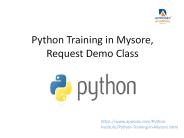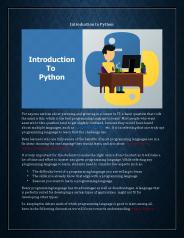Python - PowerPoint PPT Presentation
Title:
Python
Description:
Title: PowerPoint Presentation Created Date: 1/1/1601 12:00:00 AM Document presentation format: On-screen Show (4:3) Other titles: Arial Wingdings Default Design ... – PowerPoint PPT presentation
Number of Views:72
Avg rating:3.0/5.0
Title: Python
1
Python May 11
- Briefing
- Course overview
- Introduction to the language
- Lab
2
Python
- Why computer programming?
- Computer is a general-purpose machine, born to be
programmed - We want to solve many types of problems
- Our goals
- Become multi-lingual
- Practice with design implementation
- Learn by doing start simple
- Help available
- Textbook, python.org, tutorials
3
Background
- First released, 1991
- Guido van Rossum, CWI, Netherlands
- Dissatisfaction with existing languages
- High-level, multi-purpose language
- Relatively easy to learn use (we hope!)
- Procedural, object oriented or functional
- Interpreted
- Interface to OS, file system, Web
- Some data structures built into language
- Standard library
- (More details in sections 1.3 and 1.5)
4
Initial To-Do
- Essential skills special features of language
- Routine stuff
- Source file name ends in .py
- How to run interpreter (command line or IDE)
- Program structure
- I/O
- Interactive, file formatting
- Variables, identifiers
- Doing math
- Comments, tokens, whitespace, style conventions
5
continued
- Control structures
- Asking questions, repeating stuff
- nesting
- How to make comparisons
- Boolean operations and/or/not
- Functions/procedures parameters, returns
- Data structures
- String, dynamically-sized list, etc.
- Standard (i.e. run-time) library
- Random numbers, etc.
6
In the end
- How can you tell if youve mastered a language?
- Write a game
- Given a spec or algorithm, can you implement it?
- You may prefer to do something in Python!
- You never need to know everything. Know where to
find stuff quickly - This course lies between first 2 prog. courses
- Youll see more operations applications than in
the 1st course. Not as theoretical as 2nd
course.
7
Beginning
- Versions 2.x and 3.x
- Lab lets use IDE such as ActivePython
- Free, simple, includes debugger ?
- Code can by entered
- directly in shell (good for experimenting!)
- in a file, which we can save and reuse later
8
Initial nuts bolts
- Comments begin with , go to end of line
- Statements dont end in semicolon
- Dont arbitrarily indent code
- Put \ at end of line to continue statement
- Variables are not declared
- Interactive output
- Version 2.6 print statement print
name - Version 3.0 print function print
(name)
9
continued
- Examples
- print Hello, world
- print 743
- Interactive input
- input( ) for getting a number
- raw_input( ) for getting a string
- name raw_input(What is your name)
10
Whats next?
- Lab
- Please read chapter 2
- Practice with
- Basic I/O
- Mathematical operations
- Strings
- Simple if statement
- Simple loop































